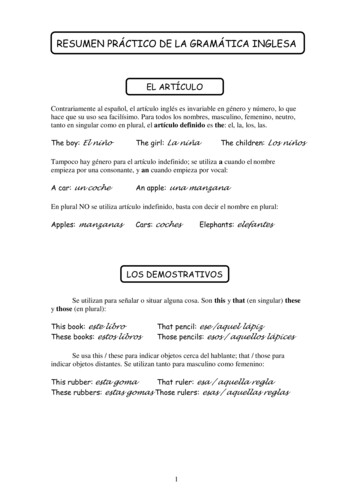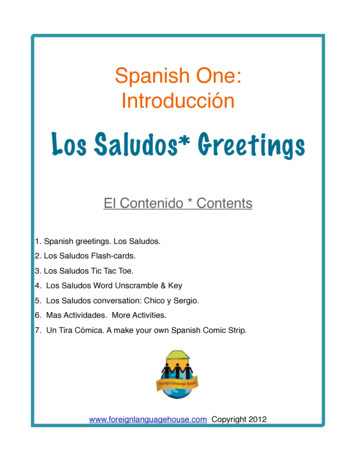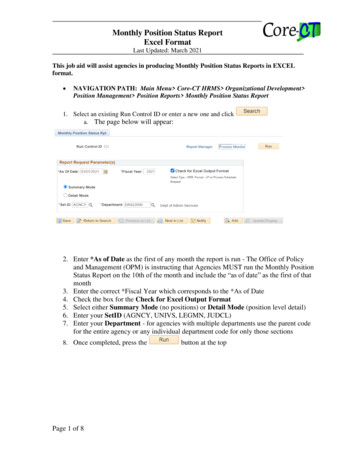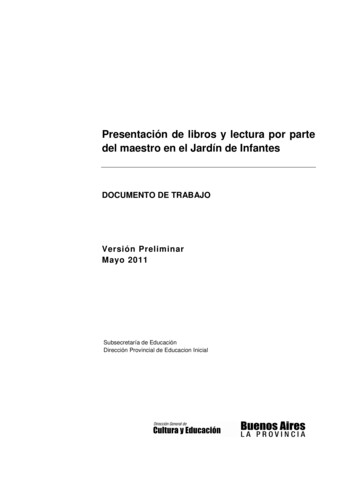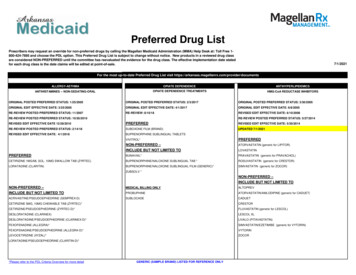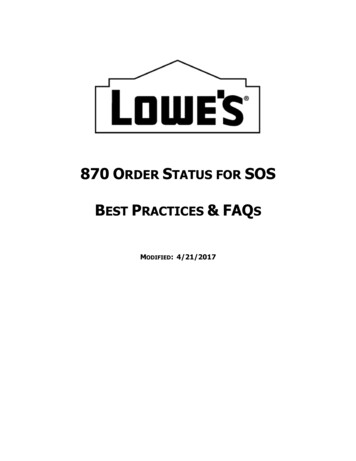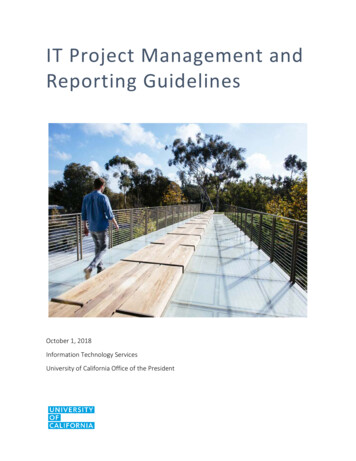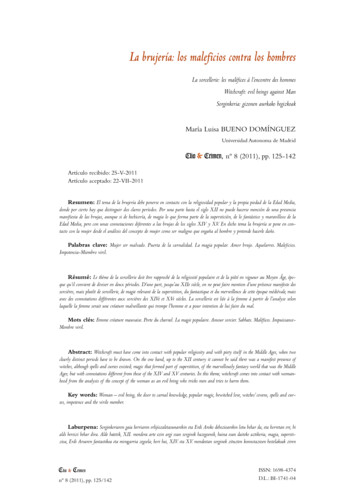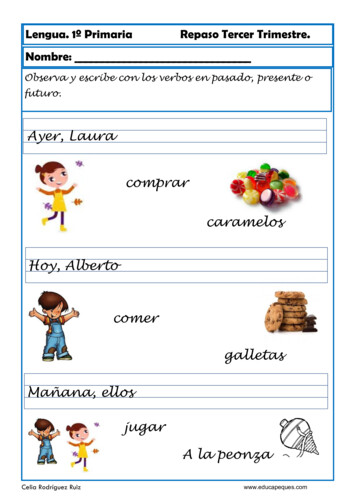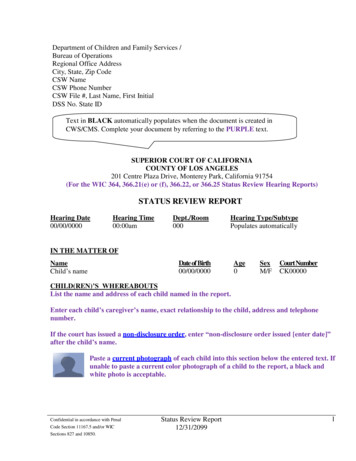
Transcription
Department of Children and Family Services /Bureau of OperationsRegional Office AddressCity, State, Zip CodeCSW NameCSW Phone NumberCSW File #, Last Name, First InitialDSS No. State IDText in BLACK automatically populates when the document is created inCWS/CMS. Complete your document by referring to the PURPLE text.SUPERIOR COURT OF CALIFORNIACOUNTY OF LOS ANGELES201 Centre Plaza Drive, Monterey Park, California 91754(For the WIC 364, 366.21(e) or (f), 366.22, or 366.25 Status Review Hearing Reports)STATUS REVIEW REPORTHearing Date00/00/0000Hearing Time00:00amDept./Room000Hearing Type/SubtypePopulates automaticallyIN THE MATTER OFDate of Birth00/00/0000NameChild’s nameAge0SexM/FCourt NumberCK00000CHILD(REN)’S WHEREABOUTSList the name and address of each child named in the report.Enter each child’s caregiver’s name, exact relationship to the child, address and telephonenumber.If the court has issued a non-disclosure order, enter “non-disclosure order issued [enter date]”after the child’s name.Paste a current photograph of each child into this section below the entered text. Ifunable to paste a current color photograph of a child to the report, a black andwhite photo is acceptable.Confidential in accordance with PenalCode Section 11167.5 and/or WICSections 827 and 10850.Status Review Report12/31/20991
Child’s nameCK numberPARENTS/LEGAL GUARDIANSName/Address/BirthdatePhoneThis information will populate from the Client Notebook.Relationship/To WhomIf a parent’s address is confidential, delete the address and enter, “Confidential.”If the identity of a parent or if the requested information in the grid is unknown, enter,“Unknown.”.If the child is legally free, enter, “Legally PhoneTo WhomInclude only those individuals who have a direct interest in the child (e.g., child’s legalguardian(s), substitute care provider, relatives when the parents’ whereabouts are unknown,etc.). It is not necessary to list collateral contacts in this section.If necessary, edit and/or enter data directly into these fields.ATTORNEYSNameAddress/RepresentingPhoneThis information automatically populates from the database. The exception is informationregarding attorneys that represent tribes or tribal organizations, which must be enteredmanually If necessary, edit and/or enter data directly into these fields.INDIAN CHILD WELFARE ACT STATUSThis information automatically populates depending on the selection made when creating thisreport.Add the date the court made its ICWA finding.NOTICESNameRelationshipMethodNotice DateIf notices are created in CWS/CMS, this information will populate automatically.If notices are created in SNAP, enter information for all parties who received a notice.SEARCH RESULTS/HISTORYIf the whereabouts of a parent are unknown and if a due diligence report for that parent wassubmitted, enter the following in the text field, “See previously submitted Due Diligence reportfor [enter the name of the parent] dated [enter date].”Status Review Report12/31/20992
Child’s nameCK numberLEGAL HISTORYHearing information in this field is populated by the database. These dates come from thehearings in which the Hearings Results pages have specific findings and/or orders entered. Ifnecessary, edit and/or enter data directly into these fields. The following information must bemanually entered: The Abuse Description The Non-Reunification section Dates for Family Maintenance (FM) reviews300 WIC Subsection(s)Initial RemovalInitial Detention OrderInitial Jurisdiction FindingInitial Disposition OrderInitial 364 FM ReviewSecond 364 FM ReviewChild’s name – 00/00/0000Initial 366.21(e) – 6 Month FR Review Initial 366.21(f) – 12 MonthFR ReviewInitial 366.22 – 18 Month FR ReviewChild’s name – 00/00/0000FR Services TerminatedNon-Reunification OrderedInitial Permanent Plan: Type/ Date OrderedCurrent Permanent Plan: Type/ Date OrderedAdditional Legal HistoryEnter the date the WIC 300 petition was filed and the date the petition was sustained.Enter the exact language of the sustained supporting fact(s) on the WIC 300 petition. If any ofthe sustained supporting fact(s) contain the exact same language, only enter the sustainedsupporting fact once.If applicable, describe the filing of any additional petitions (WIC 342, 387, or 388),jurisdictional transfers, and/or prior dependency court proceedings.If a supplemental petition was filed, indicate the date the petition was filed, the type of petition(WIC 387 or 342), and the name of the child on whose behalf the petition was filed. Indicate thedate it was sustained or dismissed. List the sustained supporting fact(s) of the petition using theexact language of the sustained supporting facts.REASON FOR HEARINGProvide a brief description of the circumstances that led to the child coming before the court.Enter, “The matter is now before the court for a status review hearing pursuant to Welfare andInstitutions Code Section [enter the appropriate code number] for the child [enter the name(s)of the child].”Status Review Report12/31/20993
Child’s nameCK numberPATERNITY/LEGAL RELATIONSHIPSProvide all available information regarding the paternity of the child.Address and provide all available supporting documentation, including dates when possible.Such documentation includes but is not limited to: Human Leukocyte Antigens (HLA) results Court orders Divorce decrees Death certificates JV-505, Statement Regarding Paternity (Juvenile Dependency)When the identity of the father is unknown, enter, "The identity of [enter the name(s) of thechild]'s father is unknown."If a court has made a paternity ruling to either rule out an alleged father or make a finding anddeclaration of paternity, indicate how this determination was made, the date of the courtruling, and the name of the court that issued the ruling. If a JV-501, Paternity – Findings andJudgment (Juvenile Dependency), is available, attach it to the report.FAMILY LAW STATUSIndicate whether or not there was a legal marriage and/or a divorce or separation.Discuss any prior family law history, custody orders, etc. Indicate the family law file number(s)if known, the date(s) of any custody order(s), and the name of the court that issued the ruling.Whenever possible, attach copies of any existing family law orders, evaluations, etc. If there isno Family Law Court involvement, indicate this fact.CRIMINAL HISTORYProvide the California Law Enforcement Telecommunications System (CLETS) and/or LiveScan results of all parents, legal guardians, and all adults living in the home including allrelatives, NREFMs, other adults residing in the home, and any youth fourteen (14) years of agewhom the CSW believes may have a criminal record.Address all clearance results in the report. Enter the person’s name and aliases and adescription of his/her arrests and/or convictions. Include the person’s probation/parole status,date probation/parole status expires, and name and phone number of current Probation/ParoleOfficer, if known. If a parent is currently incarcerated, include his/her name, and the name andlocation of the jail/prison his/her prison ID number, and his/her anticipated release date.If no criminal record was found, enter, “No criminal history known at this time,”In cases involving prospective adoptive parents or adoptive parents, present the results ofclearances with enough facts to assess child safety but without violating the confidentiality ofthe prospective adoptive or adoptive parent(s). Consult with county counsel if there are issuesregarding confidentiality.Status Review Report12/31/20994
Child’s nameCK numberIf a request has been submitted for a Live Scan report but the results have not been received,indicate who the clearance was for, the relationship to the child, the date the request wassubmitted, and that the Live Scan results have not been received.FAMILY ASSESSMENT UPDATECurrent Family CircumstancesDiscuss the family's current situation and any significant changes during the last period ofsupervision.Describe the family strengths and needs.Address issues regarding the parents/legal guardian, including but not limited to: Living circumstances Household changes Marital history and/or other significant relationship Employment status Law enforcement involvement Probation statusUse information gathered through the Family Background #1, #2 and #3 forms, as applicable.Summarize the findings of the SDM Risk Reassessment tool without referencing the tool itself.Do not attach any SDM tools when submitting documents to court, unless so ordered by thecourt.When applicable, discuss whether or not the child has been referred to the local child supportagency. Include the following statement in the report:"A determination has been made, pursuant to Family Code Section 17552, that it [is/isnot] in the best interest of the child(ren) to have the case referred to the local childsupport agency for child support services. The case [has/has not] been referred to theChild Support Services Department (CSSD)."Include the reasons behind this determination by incorporating the circumstances of the familyand by considering the best interests of the child.Additional requirements for Non-Minor Dependents (NMDs)Include the following statement and refer to the provision of the DCFS 159, Youth Advisementof Nonminor Dependency (Extended Foster Care), as applicable, and modify the statementbased on case specific circumstances:Transition/Termination of Dependency:“On [specify date]) the youth was informed of his/her right to seek termination ofdependency pursuant to Section 391 of the Welfare and Institutions Code at 18 yearsof age or anytime thereafter if dependency continues beyond the youth’s 18thbirthday. This advisement was provided by [specify social worker's name andmethod by which advisement was provided].Status Review Report12/31/20995
Child’s nameCK numberNon-Minor Dependency/Reinstatement:On [specify date] the youth was informed of the potential benefits of continueddependency as a non-minor dependent. The youth was also advised of his/her right tocontinue dependency and extend foster care, until 21 years of age, and his/her rightto have dependency reinstated as a non-minor dependent following emancipation,through the filing of a petition pursuant to Section 388(e) of the Welfare andInstitutions Code. These advisements were provided by [specify social worker'sname and method by which advisement was provided].Youth Acknowledgement of Advisements:Provide statement and/or response from the youth to each advisement including abrief assessment of the youth’s understanding of the potential benefits of continueddependency.Youth’s Plan to Remain in Foster Care:Provide youth’s statement(s) regarding his/her desires to continue dependency andto remain in foster care upon reaching eighteen (18) years of age.If the youth does not intend to remain under Juvenile Court jurisdiction as a nonminor dependent (NMD), detail the youth’s plan for transitioning to independence.Briefly discuss his/her housing, education, employment, and social support system.Youth’s Plan to Remain Eligible for Extended Foster Care Benefits:Describe youth’s plan to satisfy at least one of the eligibility criteria, to remaineligible for AFDC-Foster Care benefits after reaching 18 years of age, regardless ofwhether the youth intends to remain a non-minor dependent. The youth’s mostrecently completed Transitional Independent Living Plan (TILP) must include aplan for the youth to satisfy at least one of the criteria to remain eligible for extendedfoster care as a non-minor dependent.Agency Efforts for Youth to Meet Eligibility for Extended Foster Care:Describe all efforts made and all assistance provided to the youth by the socialworker, other DCFS staff, the out-of-home caregiver, and other service providers tomeet or maintain the youth’s eligibility for extended foster care. An example of thisdescription is as follows: “To help the youth obtain employment, during this periodof review, the assigned social worker assisted the youth in completing jobapplications, provided bus passes, and referred the youth to a communityemployment center.”If the hearing will address the termination of dependency for a youth and/or a NMD,include a factual discussion of whether it is in the best interest of the NMD to remainunder dependency jurisdiction.Status Review Report12/31/20996
Child’s nameCK numberEnter the following statement:“The youth [does/does not] have a pending application for Title XVI SupplementalSecurity Income (SSI) benefits and/or legal residency and an active dependency case[is/is not] required for that application.Specify the type and status of any pending application (e.g., SSI, Special Juvenile ImmigrationStatus).If the NMD cannot safely reside in the home of the parent or legal guardian, include thefollowing when requesting to continue or terminate reunification services: Whether the out-of-home placement continues to be necessary and appropriate Likely date by which the NMD may reside safely in the home of the parent or legalguardian or will achieve independence Whether the parent or legal guardian and the NMD were involved in thedevelopment of the Case PlanWhether the CSW has provided reasonable services to assist the parent or legalguardian in resolving the problem(s) that led to the removal of the NMDThe progress the parent or legal guardian has made toward resolving his/herproblemsWhether the NMD and the parent or legal guardian are in agreement with thecontinuation of reunification servicesWhether continued family reunification services are in the NMD’s best interestWhether there is a substantial probability that the NMD will be able to reside safelyin the home of the parent or legal guardian by the next review hearing dateEfforts to maintain the NMD’s connections with caring and committed adultsCompliance with the NMD’s TILP Case Plan, including efforts to finalize the NMD’spermanent plan and to prepare the NMD for independenceProgress in providing the NMD with information and documents related totermination of jurisdiction for a dependent child who has reached the age of eighteen(18).Evaluation of Child(ren)Create separate sections for each child.Regarding: Child’s NameMedical:Attach the Health and Education Passport (HEP) to the status review hearing report,and enter the following:“The Court is respectfully referred to the attached Health and Education Passportfor information regarding the child’s medical/health and dental status.”If pertinent information under this section needs to be reported to court but cannot berecorded in any of the fields or Comment Section of the HEP, provide a summary of thatinformation in this report by entering:Status Review Report12/31/20997
Child’s nameCK number“In addition to the information contained in the attached HEP, the following isprovided to the Court:”Developmental:Attach the Health and Education Passport (HEP) to the court report and enter thefollowing:“The Court is respectfully referred to the attached Health and Education Passportfor information regarding the child’s developmental status.”If pertinent information under this section needs to be reported to court but cannot berecorded in any of the fields or Comment Section of the HEP, provide a summary of thatinformation in this report by entering:“In addition to the information contained in the attached HEP, the following isprovided to the Court:Educational:Attach the Health and Education Passport (HEP) to the court report, and state thefollowing:The Court is respectfully referred to the attached Health and Education Passportfor information regarding the child’s educational progress.Only if pertinent information under this section needs to be reported to Court but cannotbe recorded in any of the fields or Comment Section of the HEP, provide a summary ofthat information in this report by stating:“In addition to the information contained in the attached HEP, the following isprovided to the Court:”Mental & Emotional Status:Attach the Health and Education Passport (HEP) to the court report, and enter thefollowing:“The Court is respectfully referred to the attached Health and Education Passportfor information regarding the child’s mental and emotional status.”If pertinent information under this section needs to be reported to court but cannot berecorded in any of the fields or Comment Section of the HEP, provide a summary of thatinformation in this report by entering:“In addition to the information contained in the attached HEP, the following isprovided to the Court:”OUT OF HOME PLACEMENTWhen generating the report, do not select this optional section from the dialog box if allchildren are in the home (i.e. for a WIC 364 hearing).Indicate whether the child is receiving the basic rate for that child’s age group or a specializedincrement rate by entering the following: Child's nameStatus Review Report12/31/20998
Child’s name CK numberRate type (i.e., basic, D-Rate, F-rate or ARM/Regional Center rate). Do not enter theactual dollar amount.If the child has severe emotional or behavior problems, whether or not the child isreceiving the D-rate Indicate if the assessment for the D-rate is pending. If the child has a serious medical condition, physical disability, or developmentaldelay, describe the condition and indicate whether the child is receiving orpending receipt of the F-1, F-2, F-3 or F-4 or Regional Center rate and/orsupplement. If applicable, indicate the status of a request for a Regional Center and/orsupplemental rate. If the child has an existing and/or a potential medical, mental, developmentaldisability, state if a referral and/or application has been made for SupplementalSecurity Income (SSI),the date it was made, the result of the referral/application,and/or if child is already receiving SSI and who is the payee.Discuss placement history and current placement status, including placement type/location,duration of placement, any changes during this period of supervision, adjustment to placement,continued necessity for and appropriateness of placement, and Interstate Compact on thePlacement of Children or out-of-county/courtesy supervision issues.Enter the caregiver’s comments provided on the JV-290, Caregiver Information Form w/CoverLetter, if available, and discuss any action that was taken.Regarding relative placements:Discuss any subsequent efforts made to identify and to contact relatives and/or anyupdate on the results of the due diligence efforts made in finding relatives according toestablished procedures.If the relative's home was not approved, describe the reason(s) why and provide adescription of all the efforts made to assist the relative in making the needed changes tohave his/her home approved (e.g., purchased beds or smoke detectors).If a Corrective Action Plan has been used, describe the plan and whether anyavailable funding has been accessed to assist the caregiver in correctingdeficiencies.Regarding siblings:If the child has siblings before the court or who are already under the court’sjurisdiction, describe the nature of the relationship between the child and his/hersiblings, and the appropriateness of developing or maintaining the siblings’relationships. Include information on the nature and extent of the sibling relationship,including whether: The child was raised in the same home as their sibling(s) The child shared significant common life experiences The child has existing close and strong bonds with the sibling Ongoing contact is contrary to the safety or well being of any of the siblingsStatus Review Report12/31/20999
Child’s nameCK numberDiscuss the plan to place the sibling group together unless separation is in an individualchild’s best interests pursuant to WIC 16002(b).If the siblings are not placed together in the same home, discuss why the siblingsare not placed together and either what diligent efforts are being made to placethe siblings together or why those efforts are contrary to the safety or well-beingof any of the siblings. Describe the frequency and nature of the visits between thesiblings and the impact of the sibling relationship on the child’s placementplanning for legal permanence. Include information on keeping the siblingsinformed of significant life events that occur within the extended family.Include the results of the CSWs efforts. This includes, but is not limited to: Discussions with children ten (10) years of age or older and who have been in outof-home placement for six (6) months or longer Identification of individuals other than the child's siblings who are important tothe child Actions necessary to maintain the child's relationship with those individuals,provided that those relationships are in the child’s best interestRegarding group homes:If a child is in a group home, identify any individuals who have established relationships thatare important to the child, and discuss the nature of their relationship. Discuss efforts made toensure that the child maintains a relationship with these individuals consistent with the child'sbest interest.If the child is residing in a group home, include the reason(s) or the continued need for grouphome placement.If the child is placed in a foster family agency (FFA) or group home, address the informationdetailed in the FFA or group home’s current quarterly report and attach that report to thecourt report.If recommending that the child be placed out-of-state or if the child has been placed out-ofstate, address whether the out-of-state placement would or continues to be the mostappropriate placement selection and in the best interests of the child.If the child is an American Indian and not in a placement that meets ICWA preferences,document what efforts were made to find such placement. Include dates of all actions taken.Placement History:Enter the appropriate information under the headings.Status Review Report12/31/209910
Child’s nameCK numberChild’s NameDate of Original Date of Current Total NumberPlacementPlacementof PlacementsChild EverReturn HomeChild’s Name00/00/0000Yes/No00/00/0000XSERVICES PROVIDED/FAMILY COMPLIANCEClearly describe services, including full disclosure practices, offered and/or provided to eachfamily member named in the current Case Plan. Include the progress the parents or legalguardian have or have not made toward alleviating or mitigating the causes that requiredplacement in foster care.If a parent is incarcerated, institutionalized, detained, or deported, include information aboutthe particular barriers, the parent/legal guardian's access to court ordered services, and theparent/legal guardian’s ability to maintain contact with his/her child as documented in the CasePlan.If the child is twelve (12) years or older, discuss the child’s involvement in the development andreview of his/her Case Plan and the plan for his/her permanent placement.For all youth sixteen and a half (16 ½) years old or older discuss the following: Whether a mandatory SSI disability screening has been completed Whether or not, as a result of this screening, a referral and/or application has beenmade for Supplemental Security Income (SSI) If applicable the date a referral and/or application was made and/or the result of thereferral/application Whether the child is already receiving SSIInclude the level of compliance and cooperation with maintaining contact and communicationwith service providers.Attach all reports received from the agencies that are providing services to the parent/legalguardian and to the child to the court report.VISITATIONDiscuss planned and purposeful visitation for children and families.Discuss the implementation of any court-ordered visitation plan and compliance, progress, andefforts and cooperation by the parents, siblings, and other relatives with the current visitationplan and objectives. Include the following information regarding sibling visitation: The nature of the relationship between the child and his/her siblings. The appropriateness of developing or maintaining the siblingsrelationships. If siblings are not placed together, why they are not and what efforts arebeing made to place them together, or why those efforts are notappropriate.Status Review Report12/31/209911
Child’s nameCK number Whether visits between siblings are supervised or unsupervised and thereasons for any supervision. What needs to be accomplished in order to have unsupervised visits. The length and location of the visits. Any plan to increase visitation between the siblings.If the court gave DCFS discretion to liberalize visits, indicate what specific progress was thebasis for the decision to liberalize or not liberalize the visits. This includes progress, if any, inattaining either the Case Plan and/or the visitation objectives. If appropriate, discuss the needto have the visitation objectives updated.For a child ten (10) years and older who is in out-of-home care, state efforts made to maintainrelationships between the child and specified individuals who are important to the child.Describe the current visitation plan such as the parties involved, the frequency, location,activities, and whether visitation is monitored, unmonitored, day, overnight or week-end.If supervised visitation is recommended, indicate if a monitor has been identified. If a caregiveris to supervise visits, indicate the caregiver’s willingness to supervise and if having the visitsoccur in the placement has been explored.If the child is placed in a group home or Foster Family Agency (FFA), indicate that the court’sorder regarding visitation has been shared with the agency and the agency’s efforts to promotevisitation.Indicate if the family visitation plan was discussed and documented at Team Decision-makingMeeting (TDM) or other case planning meeting(s).Include CSW’s and/or other individuals’ observations during the visits with parents, siblingsand other relatives. The observations must include the interaction amongst the parties, topics,and activities, statements, and gestures made. If someone else has observed these visits, includehis/her name, his/her relationship to the parties and their statement as to what they haveobserved. Discuss how the observations from the monitor have been used for future visitationand case planning.Include child’s, parent(s)’, and sibling(s)’ response to and statements regarding the visitation.If there is no plan for visitation, or if future family visitation is no longer appropriate, state thereasons.CONTACTSDelivered Service Log Report Attached.Either attach a copy of the Delivered Service Log showing all contacts (without displaying thenarrative portions of the contacts) or delete the “Delivered Service Log Report Attached” subheading and manually enter all contacts during the last period of supervision.Status Review Report12/31/209912
Child’s nameCK numberFAMILY’S PERCEPTION OF THEIR NEEDSEnter specific statements or a summary from children, parents, and others regarding theirperception of what they need to do to overcome the circumstances that brought them to thecourt’s attention.DETRIMENT & PROGNOSIS OF RETURNING CHILD(REN) HOMEWhen generating the report, this optional section is not selected from the dialog box if all thechildren are in the home (i.e. for a WIC 364 hearing).Describe the factors involved in what brought the family to the situation and what safety risksthe children would be placed in if they were to return to the home.Include a discussion and a projected timeframe of when the child is likely to return to thehome.If parental rights have not been terminated, provide this information in each report even if thechild is in an alternative permanent placement.If the parent or legal guardian is incarcerated, institutionalized, detained, or deported, includeinformation that the court may consider in determining detriment of family reunification. Thismay include: Age of the child Degree of parent-child bonding Length of the sentence Length and nature of the treatment Nature of the crime or illness Degree of detriment to the child if services are not offered Child's attitude toward the implementation of family reunification services for childrenten (10) years of age or older, Likelihood of the parent's discharge from incarceration, institutionalization, ordetention within the reunification time limitations.Discuss the results of the parent/legal guardian’s recent criminal background check used tohelp assess the appropriateness of returning the child to the home.CONTINUED NECESSITY FOR IN-HOME SERVICESWhen generating the report, this optional section is not selected from the dialog box if allchildren are not in the home or if the recommendation is to terminate jurisdiction.If the recommendation is to continue in-home services, describe what type of services the familyreceives, the duration of the services, and the progress of each involved person who receives theservices being provided.Explain why there is a need to continue to provide services to the family in the home, what arethe expected results from the services provided, and when the services are expected to becompleted.Summarize the findings of the SDM Risk Reassessment tool without referencing the tool itself.Status Review Report12/31/209913
Child’s nameCK numberDo not attach any SDM tools when submitting documents to court, unless ordered by the courtto do so.CONCURRENT PLANNINGWhen generating the report, this optional section is selected from the dialog box and must becompleted if one (1) or more child is in out-of-home care.Report the date the parent was advised of the option to participate in adoptive planning and tovoluntarily relinquish the child for an adoption. If the parent was not advised, specify thereason(s).Attach a copy of the Concurrent Planning Assessment (CPA) to the court report. Respectfullyrefer the court
COUNTY OF LOS ANGELES 201 Centre Plaza Drive, Monterey Park, California 91754 (For the WIC 364, 366.21(e) or (f), 366.22, or 366.25 Status Review Hearing Reports) . If the child is legally free, . If a request has bee
